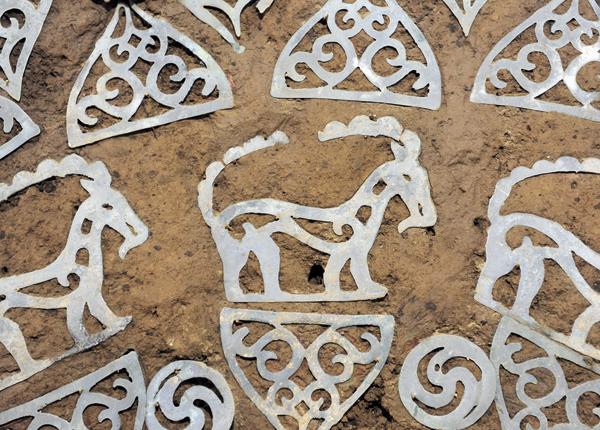 |
|
This bighorn-themed accessory from the wooden cart shows Xirong culture enjoys strong nomadic characteristics.
|
The major discovery of 60 tombs and sacrificial pits in Gansu province sheds light on the mystery of an ancient nomadic tribe along the Silk Road.
A 2,000-year-old wooden cart embellished with gold, silver and copper foil patterns is helping archeologists understand the Xirong tribal culture along the Silk Road.
Big horn sheep and tigers are among the patterns.
“It’s amazing that the metal accessories are still shiny after 2,000 years,” says Yang Xiaolin, a researcher with the National Museum of China.
The cart, one of 44, was a funerary item buried with many other objects in a cluster of tombs. The area, where excavation began in 2006, is known as the Majiayuan Graves in Muhe Township, Zhangjiachuan Hui autonomous county in northwest China’s Gansu province.
It is being restored in Lanzhou, the provincial capital, in a laboratory in the Gansu Province Cultural Relics Research Institute.
The cart is typical of vehicle structure dating back to the Warring States Period (475-221 BC).
Since 2006, archeologists have discovered 60 tombs and sacrificial pits containing 44 carts — intended to convey the departed in the next world. The discovery makes the site one of China’s most important excavations.
The richly decorated carts indicate that the owners of the graves were nobility among the Xirong tribe, according to Wang Hui, chief of the provincial research institution.
“The graves have helped us learn the history of the Xirong that had been lost for nearly 1,000 years,” Wang says. “They also provide new information to better understand the culture in southeastern Gansu, as well as the cultural connections between the Xirong and the Qin.”
Xirong is the collective name of various ancient nomadic tribal people who primarily inhabited the western region that is now Gansu and the Ningxia Hui autonomous region.
Before the discovery of the graves, archeologists knew little about the Xirong and had to rely on historic records. The graves have yielded vital evidence to unravel the mysteries of the tribe.
Since 2010, restoration of some of objects from the graves, has been carried out by the Gansu institute in cooperation with archeological departments at Cambridge University, Peking University and the Shaanxi Provincial Archaeological Institution.
We recommend:
